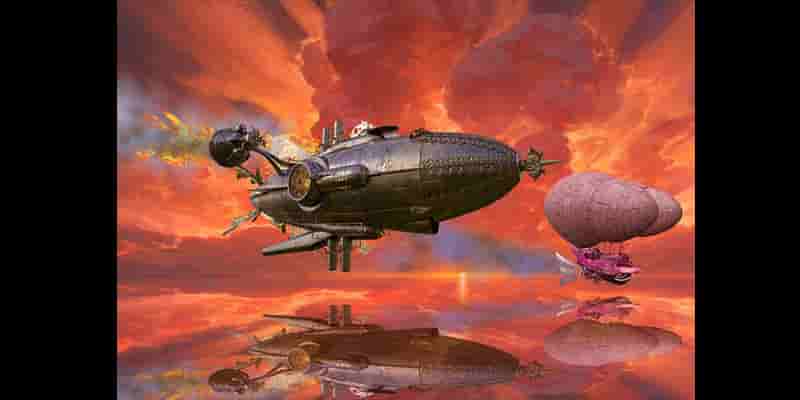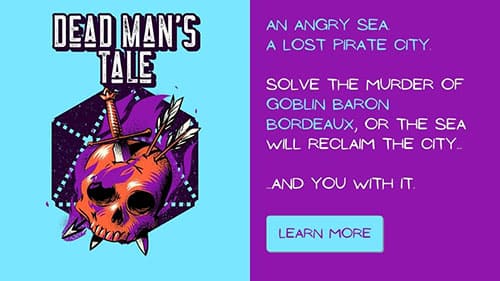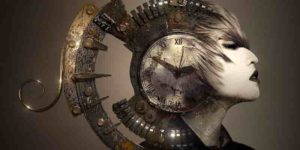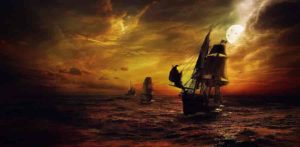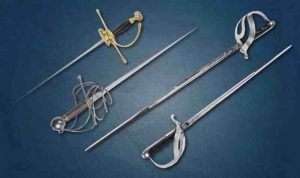When building a steampunk campaign in DnD 5e, consider these adventure elements and classes:
- Know the rules of weapons from Renaissance and Industrial Age
- Consider the world build: adventures in the sky.
- Create story beats of lost civilizations and fantastical discovery.
- Scientist/Inventor
- Hired Adventurer
- Sky Pirate
- Journalist/Researcher
Steampunk campaigns in DnD 5e can incorporate technology in new and fantastical ways—playing with historical settings to bring in the extraordinary. Common themes in this genre include nature vs industry, lost civilizations with advanced technology, technology vs magic and innovations that allow the discovery of new environments (airships, airplanes, zeppelins, submarines, capsules fired from cannons to the moon).
Plus, steampunk campaigns are perfect for homebrewing new tools and weapons with an edge of gear, steam or even magic elements of technology. Therefore, gadgets and unique weapons can offer new experiences to players who are sick of the typical magic sword or ring of power.
Also, check out our original steampunk pirate adventure, Dead Man’s Tale.
Know the rules of weapons from Renaissance and Industrial Age.
Speaking of items, we can start by learning the rules of muskets, pistols and rifles, so that our players can carry appropriate weapons for encounters. I would make it interesting by increasing the technological development of firearms as the players level higher. Therefore, the advanced weapons can come along when monster encounters get tougher.
Now, don’t take this too far and casually invent modern assault weapons. Be cool, man.
Also, bullets will cost 3 gp for 10. Plus, it’s my choice whether I want the attack rolls to be a traditional Dex + Proficiency mod or if target makes a Dexterity saving throw (DC 15).
Basic firearms I would allow for my players are:
- Muskets (500 gp): Deal 1d12 piercing damage at a range of 40/120. Then, reload as an action—unless you have a special bonus action of Sleight of Hand like the Thief.
- Pistols (250 gp): Deal 1d10 piercing damage at a range of 30/90. Reload as an action like the musket.
- Blunderbuss (300 gp): 2d8 piercing damage. Burst fire property sprays 10 bullets in 10-foot cube.
- Bomb (150 gp): Throw a bomb up to 60 feet away. Explosion hits enemies within 5 feet of landing spot who fail a Dexterity save (DC 12).
- Revolver (rare): 2d8 piercing damage at a range of 40/120. As you can imagine, you get six shots between reloads.
- Hunting Rifle (rare): Deal 2d10 piercing damage at a range of 80/240 with 5 shots between reloads.
Consider the world build: adventures in the sky.
As I mentioned above, the steampunk genre thrives on the concept of exploration and discovery. Therefore, the sky is often used as a thematic setting in these stories—complete with sky pirates, floating islands and expansive cloud oceans.
One of my favorite sources of steampunk worldbuilding comes from Hayao Miyazaki’s Castle in the Sky. Miyazaki creates a world of flying vehicles, sky pirates and floating islands harboring advanced, ancient technology and robots. As far as high-flying sky settings go, I would suggest this movie for inspiration.
Related Posts:
Guide to Building Puzzles in Your Campaign: DnD 5e
| Guide to Building Pirate Characters: DnD 5e
|
However, we also have deep seas to consider—something more along the line of early 20th Century science fiction like Jules Verne’s 20,000 Leagues Under the Sea. Perhaps a hidden civilization exists in a strange pocket of air that refreshes itself. Plus, we can include water-breathing spells and items to venture out into the depths.
Finally, consider a fantastical trip to the moon. Early sci-fi was wild, full of wonder about the heavenly bodies we commonly see from Earth. However, they didn’t know much about how outer space works (you know, vacuums and radiation). Therefore, consider a different kind of moon adventure—one from the fantastical eyes of the past.
Create story beats of lost civilizations and fantastical discovery.
Now that we have an idea for the theme and environment of our adventure, let’s take a look at how we can adventure build. For some inspiration in launching a steampunk campaign, consider the following prompts:
- A party member has come to own a special map to a hidden city in the clouds. Now, the crew must board an airship to venture toward the floating kingdom for treasure. Cloud giants or automatons of an advanced civilization may lurk in the legendary castle.
- An explorative research team hires the party as bodyguards on an expedition to the moon. However, a competing team has nefarious plans to find the discovery first. Oh, and don’t forget the kingdom of moon people—a fairy-like race could fit nicely for a fantasy edge.
- Signs of a sunken civilization are beginning to reemerge as reports of silvery flying vehicles fall on a coastal town. Now, the party is in charge of an investigation that leads to a spectacular underwater world.
Scientist/Inventor
The scientist or inventor trope is common among steampunk protagonists. Whether this tinkerer is a gifted young mechanic or fringe scientist on the verge of fantastic discovery, the character has a strong drive for exploration. Plus, this guy is good with his hands—often coming up with inventions on the fly.
Naturally, the artificer alchemist would fit this theme well. Artificer alchemists can create an array of effects (health, speed, transformation…) with potions made by expending spell slots. With a bonus potion each day, magically infused items, firearm proficiency and a potential homunculus pet, the alchemist is a true scientist—kind of.
Wizards also fit this trope—albeit in a magic, D&D sort of way. The type of magic wizards learn is more scholarly and studied, effectively making them the original scientists in a world of magic. High Intelligence and long list of spells will help this character investigate mysterious civilizations of the past. The School of Transmutation manipulates energy and matter the way a chemist might with a lab.
Hired Adventurer
The Hired Adventurer is a gun-slinging rogue or ranger whose jobs are to keep the party alive, navigate dungeons and disarm traps. This character is often the first mercenary sought out by a funded explorer—a fellow adventurer brave enough to test the unknown for a prize.
A rogue thief would fit this dashing character and add in several benefits to the party. Firstly, a thief in DnD 5e is a master of magic items, obsessing over treasure and experienced in retrieving said treasure. Plus, I’ll have all the stealth, lockpicking and ambush tactics of a rogue, including Sneak Attack for enhanced damage (2d6 to start) and Expertise to double my proficiency in certain skills.
Check out my complete thief build here.
On the other hand, a ranger hunter could act as a master tracker and slayer, acting as a navigator and bodyguard. I’ll likely stick with the Archery fighting style to begin (who needs all the reloading). Plus, options like Colossus Slayer and Escape the Horde give me extra damage and opportunities to maneuver in combat. Naturally, spells like speak with animals, hunter’s mark and cure wounds can make me the swiss army knife of the group. Later, this character could evolve to incorporate six-shooters and hunting rifles.
Sky Pirate
One of my favorite steampunk archetypes is the sky pirate—a scoundrel mercenary (perhaps with a heart of gold) who operates or mans a rogue airship. This build can take many forms, but some of my favorites are from the artificer class. In fact, the armorer, artillerist and battlesmith would make a fun bunch of pirates.
Throw in an alchemist and we have a party. Then, the whole crew could be made up of artificers.
Check out my artificer artillerist build here.
Consider variants in crewmates. Of course, a goblin or hobgoblin artillerist and bomb maker could be a fun agent of chaos. Or I could tap into the tinkering nature of rock gnomes as a kind of ironic character—a creature of the earth working as an airship mechanic. Finally, consider flying races like aarocokra or owlfolk who can exit the ship and scout the clouds.
Journalist/Researcher
Finally, the journalist/researcher is a writer and storyteller thrilled to cover the exploits and discoveries of a fantastical world. These characters are often young and bright-eyed—a type of point-of-view character to understand the surrounding world. Therefore, this character archetype can easily be translated into a bard—someone who makes magic from language.
A bard College of Lore can utilize knowledge and charisma to great effect, inspiring the party with Bardic Inspiration (add 1d6 to ally’s roll). Plus, they know a surprising amount about everything. A collection of illusion and charm spells play off my Charisma score, which also comes in handy for social situations. Also, the College of Lore adds extra spells and Cutting Words (subtract 1d6 from an enemy roll). As the party adventures along, this character will transcribe the quest in spectacular fashion.
For a more adventurous bard option, try College of Swords. Now, we can utilize Bardic Inspiration for dexterous maneuvers with a rapier, swashbuckling like Zorro and charming the NPCs.
Related articles:
Guide to Building Puzzles in Your Campaign: DnD 5e
| Guide to Building Dinosaur Campaigns: DnD 5e
|

